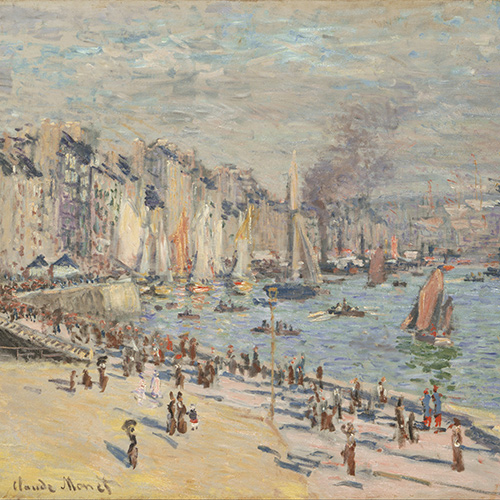
Port of Le Havre by Claude Monet, 1874
Impressionism ignited in the rolling green countryside of Normandy, France, where Claude Monet and other local artists developed this new way of painting, shocking many traditionalists. Impressionists rebelled against the classical art tradition by painting outdoors and representing the modern world, emphasizing landscapes and everyday life. They especially focused on capturing the essence of light and how it could define a moment, creating such gems as Monet’s Impression, Sunrise and Rouen cathedral series; Pierre-Auguste Renoir’s Luncheon with the Boating Party; and Mary Cassatt’s Little Girl in a Blue Armchair.
Travel writer Barbara Noe Kennedy takes you to visit the sites where this extraordinary artistic movement was born and evolved—even the exact places where well-known paintings were created. Explore seascape and towns in the countryside, before heading to the Paris area to discover more sites related to the history of Impressionism. Maps, photos, videos, and other visuals accompany the journey.
May 29 The Origins of Impressionism in Normandy
Start in charming Honfleur, where it all began, then head off to explore Étretat, whose white cliffs inspired Pissarro, Sisley, and Caillebotte; the seaside towns of Dieppe, Sainte-Adresse, Deauville, and Trouville-sur-Mer; Rouen, made famous by Monet’s cathedral series; Le Havre, where Monet painted Impression, Sunrise and which now has a superb museum and a walking trail that follows the painters’ footsteps and other locales. Hear stories about the artists in each place and visit the precise spots where painters stood to create some of Impressionism’s most enduring works—and which look nearly the same today. The last stop is Giverny, where Monet created and painted his lily pond and lived for 43 years.
June 5 Beyond Normandy
Next up are a scattering of sites in and around Paris where the Impressionists flourished. Chief among them is Auvers-sur-Oise, where many painters lived and worked, including Camille Pissarro, Charles-François Daubigny, and Jean-Baptiste-Camille Corot, and which looks as enchanting today as it did then. Paul Cézanne produced his paintings that were the closest to the Impressionist style here, and this is also where Post-Impressionist Vincent van Gogh spent the last months of his life, painting furiously.
Visit the suburb of Chatou, Renoir’s “prettiest little place near Paris” (depicted in his Luncheon of the Boating Party); Ile de la Jatte, the backdrop for Georges Seurat’s masterpiece, A Sunday Afternoon on the Island of La Grande Jatte; Moret-sur-Loing, Alfred Sisley’s home; and Gustave Caillebotte’s estate at Yerres, nicknamed “the other Giverny.” Finish up with several great Paris museums to view examples of Impressionist art, including the Musée d’Orsay, Musée de L’Orangerie, and Musée Marmottan Monet.
Kennedy worked for 23 years with National Geographic Travel Publishing and served as an expert on National Geographic Expeditions to France and Italy.
2 sessions
World Art History Certificate elective: Earn 1/2 credit per session*
General Information
*Enrolled participants in the World Art History Certificate Program receive 1/2 elective credit per session. Not yet enrolled? Learn about the program, its benefits, and how to register here.